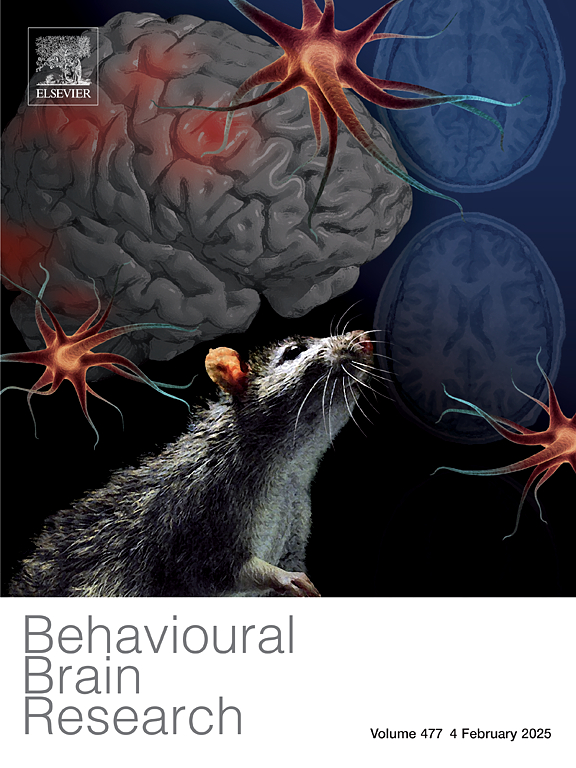帕金森病临床前模型中6-OHDA损伤大鼠的性别差异
IF 2.6
3区 心理学
Q2 BEHAVIORAL SCIENCES
引用次数: 0
摘要
尽管帕金森氏病(PD)于1817年首次被描述,但其病因尚不清楚。PD中受影响的主要神经递质系统是黑质纹状体多巴胺能通路,其功能障碍导致该疾病的标志性运动症状。这些运动症状通常仅在大约80%的多巴胺能神经元丢失后出现,使早期检测和干预复杂化。因此,在症状出现之前了解更多的阶段是很重要的,这些阶段可能代表疾病的进展。此外,大量证据表明PD的患病率和进展存在性别差异,男性比女性更容易受到影响。然而,大多数PD动物模型的临床前研究仅在男性身上进行,限制了我们对性别间神经化学和行为差异的理解,特别是在中度多巴胺能病变下。为了解决这个问题,我们使用PD的单侧6-羟基多巴胺(6-OHDA)模型,诱导黑质致密部(SNpc)中度病变来研究性别特异性差异。我们的研究揭示了雄性和雌性动物不同的神经化学和行为特征,包括对安非他明和阿波啡的性别特异性反应。这些药理学试验突出了两性之间不对称和对称行为的对比模式。此外,我们考虑了在动物模型中经常被忽视的个体变异性,这可以提供对多巴胺能丧失的恢复力或易感性的关键见解。这些发现强调了将性别作为PD研究中的一个生物学变量的重要性,以更好地了解该疾病的潜在机制,并改进早期诊断和治疗干预策略。本文章由计算机程序翻译,如有差异,请以英文原文为准。
Sex differences in 6-OHDA lesioned rats in a preclinical model for Parkinson’s disease
Although Parkinson’s disease (PD) was first described in 1817, its etiology remains unclear. The primary neurotransmitter system affected in PD is the nigrostriatal dopaminergic pathway, whose dysfunction leads to the hallmark motor symptoms of the disease. These motor symptoms typically emerge only after approximately 80 % of dopaminergic neurons are lost, complicating early detection and intervention. For this reason, it is important to know more about the stages prior to the appearance of symptoms that could represent the progression of the disease. Additionally, substantial evidence suggests sex differences in PD prevalence and progression, with men more frequently affected than women. However, most preclinical studies using animal models of PD have been conducted exclusively on males, limiting our understanding of neurochemical and behavioral differences between sexes, particularly under moderate dopaminergic lesions. To address this, we used the unilateral 6-hydroxydopamine (6-OHDA) model of PD, inducing moderate lesions in the substantia nigra pars compacta (SNpc) to investigate sex-specific variations. Our study revealed distinct neurochemical and behavioral profiles in male and female animals, including sex-specific responses to amphetamine and apomorphine challenges. These pharmacological tests highlighted contrasting patterns in asymmetric and symmetric behaviors between sexes. Moreover, we considered individual variability often overlooked in animal models, which could provide critical insights into resilience or susceptibility to dopaminergic loss. These findings underscore the importance of incorporating sex as a biological variable in PD research to better understand the disease’s underlying mechanisms and to improve strategies for early diagnosis and therapeutic intervention.
求助全文
通过发布文献求助,成功后即可免费获取论文全文。
去求助
来源期刊

Behavioural Brain Research
医学-行为科学
CiteScore
5.60
自引率
0.00%
发文量
383
审稿时长
61 days
期刊介绍:
Behavioural Brain Research is an international, interdisciplinary journal dedicated to the publication of articles in the field of behavioural neuroscience, broadly defined. Contributions from the entire range of disciplines that comprise the neurosciences, behavioural sciences or cognitive sciences are appropriate, as long as the goal is to delineate the neural mechanisms underlying behaviour. Thus, studies may range from neurophysiological, neuroanatomical, neurochemical or neuropharmacological analysis of brain-behaviour relations, including the use of molecular genetic or behavioural genetic approaches, to studies that involve the use of brain imaging techniques, to neuroethological studies. Reports of original research, of major methodological advances, or of novel conceptual approaches are all encouraged. The journal will also consider critical reviews on selected topics.
 求助内容:
求助内容: 应助结果提醒方式:
应助结果提醒方式:


